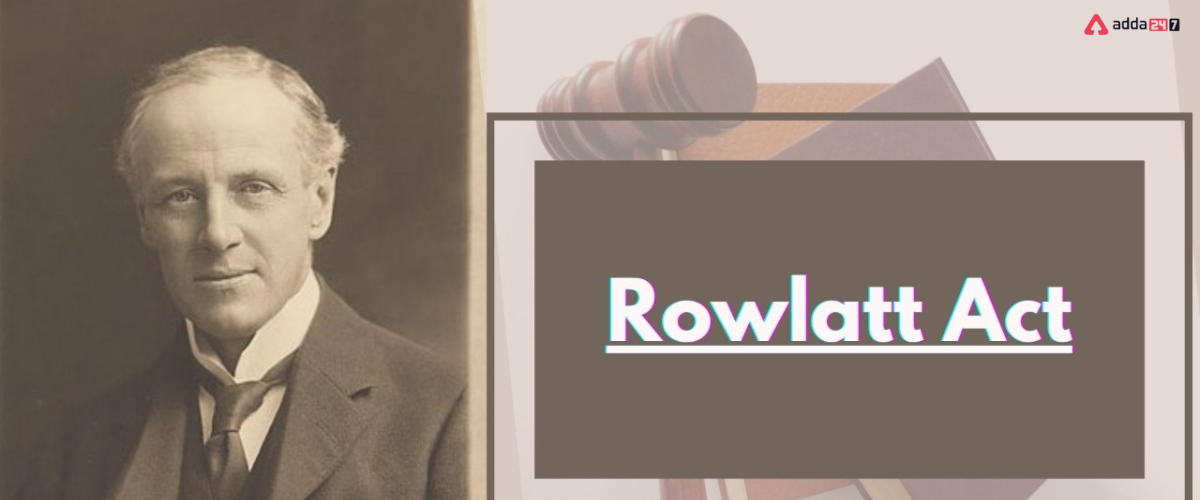What is Rowlatt Act 1919?
What is Rowlatt Act- The brutal law enacted by the British government in March 1919 is referred to as the Rowlatt Act, Rowlatt Satyagraha, or the Black Act. The Anarchical and Revolutionary Crimes Act, as it is officially known, granted the British government and police the authority to detain anyone accused of seditious behavior. It was intended to replace the Defence of India Act of 1915, which dealt with emergencies. A committee led by a British judge named Sir Sydney Rowlatt created the Black Act to stifle India’s rising nationalist movement. Check here for All information about What is Rowlatt Act?
What was rowlatt act and its effect?
What was Rowlatt Act and its effect are mentioned below.
- The law provided the government with the right to imprison any suspect for up to two years without a trial and arrest them without a warrant.
- The measure suspended the constitutional right to habeas corpus and removed people’s ability to engage in legal discourse.
- In the years following World War I, the Rowlatt act expanded the emergency law.
- The statute also severely curtailed journalistic freedom and gave police unwarranted authority to search public and private areas without a warrant.
- A permanent prohibition on all kinds of public gatherings.
The unofficial Indian members of the legislature vigorously opposed the Act, but the parliamentary assembly passed the infamous bill into law in March 1919. Numerous Indian leaders, including Mohammad Ali Jinnah, left the legislative body and denounced the British Empire’s autocracy and the absence of constitutional protections for Indian residents. Indian citizens, particularly those from Punjab who had valiantly fought alongside the British troops in the First World War, were further alienated by the act (1914 to 1918).
On April 6, 1919, Mahatma Gandhi began a national satyagraha (campaign of peaceful civil disobedience) in opposition to the Rowlatt Act. The movement has the support of millions of Indians. The movement became violent, and riots broke out across India. The worst crisis occurred in the region of Punjab, where the British administration imposed martial law, and Mahatma Gandhi halted the movement. Many important Congress leaders, including Satya Pal and Saifuddin Kitchlew, were detained as the rally descended into violence. Under martial law, Punjab was only permitted to have gatherings of up to 4 people.
What is Rowlatt act Class 10?
- Two pieces of legislation were submitted to the federal legislature in February 1919 in accordance with the recommendations of the committee, which was presided over by Justice Rowlatt. The notes were identified as “black bills.”
- They gave the police broad authority to conduct warrantless searches and detain whomever they wanted.
- This legislation essentially granted the government the power to deal with any cases of revolutionary activity in the British Raj and allowed the imperial authorities the authority to hold anyone charged with terrorism in the British Raj for up to two years without a trial.
- It allowed for harsher press controls, the ability to make arrests without a warrant, the authority to hold suspects indefinitely without charge or trial and the ability to hold secret tribunals for illegal political activity.
- The identities of their accusers and the type of evidence used against the undertrials for their alleged crimes were likewise withheld from them.
- No Dalil, No Vakil, No Appeal, which means no pleads, no lawyer, and no appeal, was one well-known description of the legislation at the time.
- The measure was passed in order to stifle the nation’s growing nationalist movement.
- After serving their sentences, the offenders were prohibited from engaging in political, religious, or educational activities and were compelled to post security as assurance of their good behaviour.
- According to the Act, people who have been apprehended must go before special tribunals created for that purpose.
- Additionally, this legislation upheld the assertion that it is an offence to possess treasonous literature.
Ace your class 10th board exams with Adda247 live classes for class 10th preparation.
What is Rowlett act Shortcomings for Class 10 Notes
- The Act infuriated many Indian politicians and the populace as a whole, forcing the government to take harsh measures.
- The Act allowed the government to hold anybody suspected of revolutionary actions for up to two years without accusation or trial.
- Additionally, it enabled the indefinite detention and arrest of a person without a warrant. Trials without a jury were another provision, and political speech was forbidden.
- After their release, convicted individuals were required to deposit assets and refrain from engaging in political, religious, or educational activities.
- The Rowlatt Act significantly curtailed press freedom as well.
- Fundamental human rights and legal rights are violated by this Act.
- This legislation aimed to promote arbitrary behaviour by giving the government vast discretionary authority.
- Several sections lack procedural elements because of their legal standpoint.
Rowlatt Act- Timeline
| Date | Event of Rowlatt Act |
| 1917 | The Government of India appointed a committee headed by Justice Sydney Rowlatt to investigate ‘seditious activities in India and bring out measures to curb the revolution. |
| 1919 | In March 1919, the British government passed the Anarchical and Revolutionary Crimes Act, popularly called the Rowlatt Bill despite popular opposition. |
| 1919 | In April 1919, in opposition to the draconian law that threatened the civil liberties of the Indians, Mahatma Gandhi launched nationwide satyagraha. |
| 1919 | Mahatma Gandhi cancelled the nationwide hartal as the movement grew violent. Riots broke out in India, and Punjab was the worst hit; it was put under Martial Law. On 13th April 1919, the traumatic Jallianwala Bagh massacre occurred, a group of peaceful protestors gathered in the park, and Lieutenant Governor of Punjab, Michael O’Dwyer, opened fire and killed hundreds of injured thousands of people. |
| In October 1919 | The Hunter Commission was appointed by the Government of India to investigate the Jallianwala bagh incident. |
| 1922 | Rowlatt Act was repealed by Lord Reading |
What Is Rowlatt Act (रॉलेट एक्ट) in Hindi
रॉलेट एक्ट क्या है- मार्च 1919 में ब्रिटिश सरकार द्वारा बनाए गए क्रूर कानून को रॉलेट एक्ट, रॉलेट सत्याग्रह या ब्लैक एक्ट के रूप में जाना जाता है। अराजक और क्रांतिकारी अपराध अधिनियम, जैसा कि आधिकारिक तौर पर जाना जाता है, ने ब्रिटिश सरकार और पुलिस को देशद्रोही व्यवहार के आरोपी किसी को भी हिरासत में लेने का अधिकार दिया। इसका उद्देश्य 1915 के भारत रक्षा अधिनियम को प्रतिस्थापित करना था, जो आपात स्थितियों से निपटता था। सर सिडनी रॉलेट नामक एक ब्रिटिश न्यायाधीश के नेतृत्व में एक समिति ने भारत के बढ़ते राष्ट्रवादी आंदोलन को दबाने के लिए ब्लैक एक्ट बनाया। रोलेट एक्ट क्या है, इसके बारे में सभी जानकारी के लिए यहां देखें।
रॉलेट एक्ट क्या है और इसका प्रभाव क्या है?
रॉलेट एक्ट क्या है और इसके प्रभाव का उल्लेख नीचे किया गया है।
कानून ने सरकार को बिना किसी मुकदमे के किसी भी संदिग्ध को दो साल तक की कैद और बिना वारंट के गिरफ्तार करने का अधिकार प्रदान किया।
इस उपाय ने बंदी प्रत्यक्षीकरण के संवैधानिक अधिकार को निलंबित कर दिया और लोगों की कानूनी बातचीत में शामिल होने की क्षमता को हटा दिया।
प्रथम विश्व युद्ध के बाद के वर्षों में, रॉलेट एक्ट ने आपातकालीन कानून का विस्तार किया।
क़ानून ने पत्रकारिता की स्वतंत्रता को भी गंभीर रूप से कम कर दिया और पुलिस को बिना वारंट के सार्वजनिक और निजी क्षेत्रों में तलाशी लेने का अनुचित अधिकार दिया।
सभी प्रकार के सार्वजनिक समारोहों पर स्थायी प्रतिबंध।
विधायिका के अनौपचारिक भारतीय सदस्यों ने अधिनियम का पुरजोर विरोध किया, लेकिन संसदीय सभा ने मार्च 1919 में कुख्यात विधेयक को कानून में पारित कर दिया। मोहम्मद अली जिन्ना सहित कई भारतीय नेताओं ने विधायी निकाय छोड़ दिया और ब्रिटिश साम्राज्य की निरंकुशता और संवैधानिक की अनुपस्थिति की निंदा की। भारतीय निवासियों के लिए सुरक्षा। भारतीय नागरिक, विशेष रूप से पंजाब के वे लोग जिन्होंने प्रथम विश्व युद्ध में ब्रिटिश सैनिकों के साथ बहादुरी से लड़ाई लड़ी थी, उन्हें अधिनियम (1914 से 1918) द्वारा और अलग कर दिया गया था।
6 अप्रैल, 1919 को महात्मा गांधी ने रॉलेट एक्ट के विरोध में एक राष्ट्रीय सत्याग्रह (शांतिपूर्ण सविनय अवज्ञा का अभियान) शुरू किया। इस आंदोलन को लाखों भारतीयों का समर्थन प्राप्त है। आंदोलन हिंसक हो गया और पूरे भारत में दंगे भड़क उठे। सबसे बुरा संकट पंजाब के क्षेत्र में हुआ, जहां ब्रिटिश प्रशासन ने मार्शल लॉ लगाया और महात्मा गांधी ने आंदोलन को रोक दिया। सत्य पाल और सैफुद्दीन किचलू सहित कई महत्वपूर्ण कांग्रेस नेताओं को हिरासत में लिया गया क्योंकि रैली में हिंसा हुई। मार्शल लॉ के तहत, पंजाब को केवल 4 लोगों के इकट्ठा होने की अनुमति थी।
रॉलेट एक्ट 10वीं कक्षा के लिए सरल शब्दों में क्या है?
समिति की सिफारिशों के अनुसार फरवरी 1919 में संघीय विधायिका को कानून के दो टुकड़े प्रस्तुत किए गए थे, जिसकी अध्यक्षता न्यायमूर्ति रॉलेट ने की थी। नोटों की पहचान “ब्लैक बिल” के रूप में की गई थी।
उन्होंने पुलिस को वारंट रहित तलाशी करने और जिसे चाहें उसे हिरासत में लेने का व्यापक अधिकार दिया।
इस कानून ने अनिवार्य रूप से सरकार को ब्रिटिश राज में क्रांतिकारी गतिविधि के किसी भी मामले से निपटने की शक्ति प्रदान की और शाही अधिकारियों को बिना किसी मुकदमे के दो साल तक ब्रिटिश राज में आतंकवाद के आरोप में किसी को भी पकड़ने का अधिकार दिया।
इसने कठोर प्रेस नियंत्रण, वारंट के बिना गिरफ्तारी करने की क्षमता, बिना किसी आरोप या मुकदमे के संदिग्धों को अनिश्चित काल तक पकड़ने का अधिकार और अवैध राजनीतिक गतिविधि के लिए गुप्त न्यायाधिकरण रखने की क्षमता की अनुमति दी।
उनके अभियुक्तों की पहचान और उनके कथित अपराधों के लिए विचाराधीन कैदियों के खिलाफ इस्तेमाल किए गए सबूतों के प्रकार भी उनसे रोक दिए गए थे।
कोई दलील नहीं, कोई वकील नहीं, कोई अपील नहीं, जिसका अर्थ है कोई दलील नहीं, कोई वकील नहीं, और कोई अपील नहीं, उस समय कानून का एक प्रसिद्ध विवरण था।
देश के बढ़ते राष्ट्रवादी आंदोलन को दबाने के लिए यह उपाय पारित किया गया था।
अपनी सजा काटने के बाद, अपराधियों को राजनीतिक, धार्मिक या शैक्षिक गतिविधियों में शामिल होने से प्रतिबंधित कर दिया गया था और उनके अच्छे व्यवहार के आश्वासन के रूप में सुरक्षा पोस्ट करने के लिए मजबूर किया गया था।
अधिनियम के अनुसार, जिन लोगों को गिरफ्तार किया गया है, उन्हें उस उद्देश्य के लिए बनाए गए विशेष न्यायाधिकरणों के समक्ष जाना चाहिए।
इसके अतिरिक्त, इस कानून ने इस दावे को सही ठहराया कि देशद्रोही साहित्य रखना अपराध है।
Found this article helpful?
Let’s connect via chat or call our senior expert counsellor at +91-9625869989 to learn more about the different streams and options available.
We would love it if we could add some of your insights. If you have a definite goal of scoring the highest marks, then you can resolve your doubts via our app/quizzes and youtube class assistance (https://youtube.com/c/Adda247Class9and10)
What Is Rowlatt Act for Class 10-QNAs
Ques 1. Who was behind the Rowlatt Act?
Ans. The Rowlatt Committee, headed by Sir Sydney Rowlatt, approved the Act. It permitted the detention of any British Indian citizen accused of terrorism for a period of two years without a trial.
Ques 2. Where was Rowlatt Act passed?
Ans. In 1919, the Imperial Legislative Council approved the Rowlatt Act.
Ques 3. What was the Rowlatt Act’s alternate name?
Ans. The British government passed the Rowlatt Act, also known as the “black act,” in 1919 during the First World War.
Ques 4. What does the Rowlatt Act’s primary goal?
Ans. The Rowlatt act’s primary goal was to restrict Indian citizens’ fundamental rights.









 MGSU Result 2025 Out, Download Maharaja ...
MGSU Result 2025 Out, Download Maharaja ...
 EMS Results 2025 OUT at gnanasangama.kar...
EMS Results 2025 OUT at gnanasangama.kar...
 How to Calculate CUET Score, Check Marks...
How to Calculate CUET Score, Check Marks...

